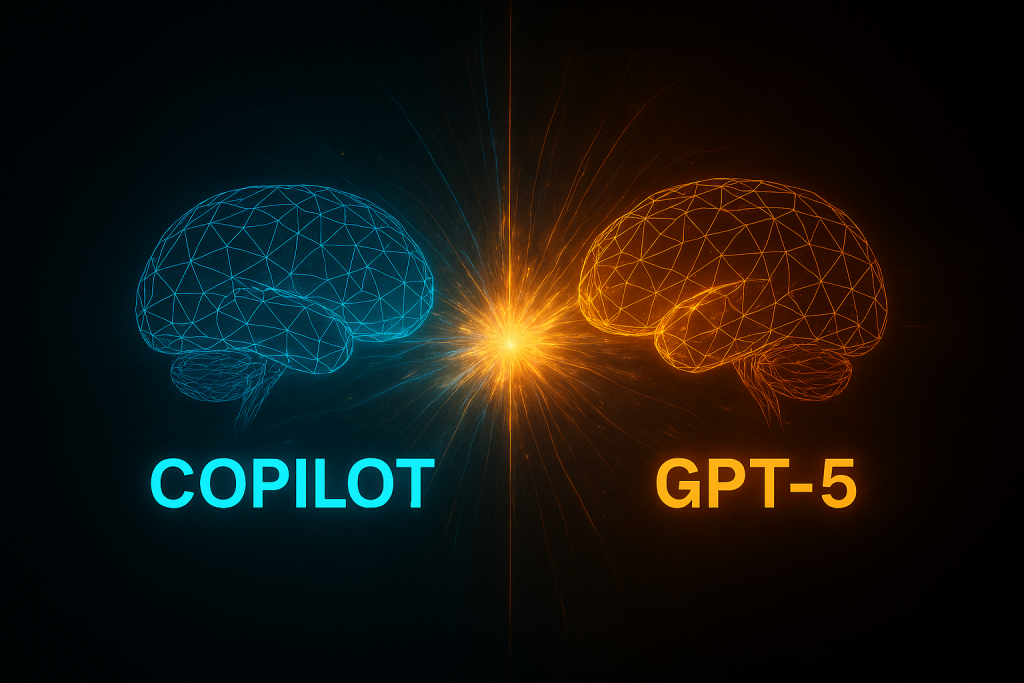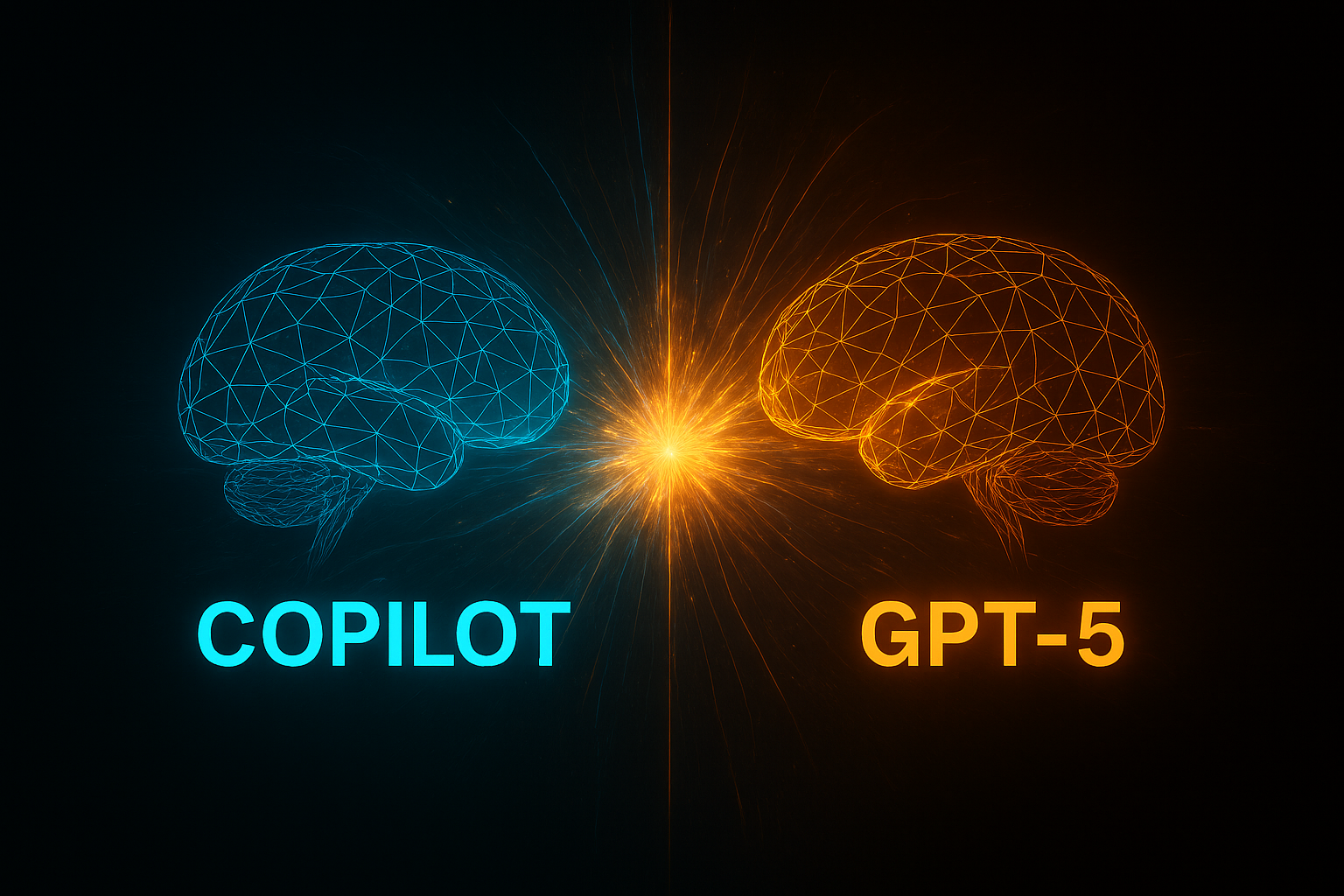🦉 Chapter 1: From Sidekick to Backbone — The GPT-5 Copilot Upgrade
Microsoft’s rollout of the GPT-5 Copilot across its ecosystem isn’t just a model swap — it’s a philosophical pivot. Copilot is no longer a reactive assistant waiting for commands. It’s now a proactive collaborator that adapts to your workflow, interprets your intent, and responds with context-aware intelligence.
The new “Smart Mode” is the centerpiece of this shift. Instead of toggling between fast replies and deep analysis, Copilot now chooses the right approach automatically. Whether you’re drafting a quick reply or synthesizing a multi-source report, GPT-5 adjusts its reasoning depth on the fly.
This upgrade democratizes access to advanced AI. GPT-5 is available to all users — no subscription required — across Windows, Mac, mobile, and web platforms.
📎 ZDNet’s full breakdown 📎 Microsoft’s official announcement

🧠 Chapter 2: Microsoft 365 Copilot — Enterprise AI with a Memory
In the enterprise realm, GPT-5 transforms Microsoft 365 Copilot into a reasoning engine that understands not just what you ask, but why you’re asking. It draws from your organization’s entire Microsoft Graph — emails, documents, meetings, chats — to deliver responses grounded in real work context.
This isn’t just smarter summarization. It’s contextual synthesis. Copilot can prep you for a workshop by pulling insights from your inbox, calendar, and shared documents — all without manual setup. The real-time model router selects the best GPT-5 variant for each task, eliminating the need for users to understand model hierarchies or switch modes.
📎 RedmondMag’s enterprise analysis
💻 Chapter 3: GitHub Copilot & VS Code — Agentic Coding Comes Alive
For developers, the GPT-5 Copilot in GitHub is a leap toward agentic programming. It doesn’t just autocomplete code — it understands your project’s architecture, documentation, and design assets. The new “chat checkpoints” feature lets you rewind your coding session to any moment, restoring both workspace state and Copilot’s memory.
Agent sessions allow for multi-step planning and execution across repositories. Whether you’re debugging a plugin or building a hybrid AI workflow, GPT-5 now acts like a coding partner that learns from your logic and adapts to your style.
📎 How to activate GPT-5 in VS Code
☁️ Chapter 4: Azure AI Foundry — The Model Router Revolution
Azure AI Foundry now offers instant access to four GPT-5 variants — standard, mini, nano, and chat — each optimized for different use cases. The real-time model router evaluates each prompt and selects the best model based on complexity, latency, and cost-efficiency.
This means developers can focus on building, not backend wrangling. Whether you’re deploying a chatbot, running a simulation, or integrating GPT-OSS into a custom app, Foundry handles the orchestration invisibly.
📱 Chapter 5: Consumer Copilot — GPT-5 in Your Pocket
The Copilot app now includes GPT-5-powered Smart Mode, accessible without a Microsoft account. This isn’t just a chatbot — it’s a mobile-first productivity engine. You can brainstorm, plan travel, generate content, and even edit stories in real time using Copilot Pages.
Voice integration with Bing and Edge allows for hands-free interaction, while free-tier users get five times more GPT-5 queries daily than ChatGPT’s free tier — a quiet but meaningful advantage.
📎 HotHardware’s Smart Mode test drive 📎 Beebom’s consumer rollout summary
🧪 Chapter 6: Real-World Tests — GPT-5 vs. ChatGPT
Microsoft’s internal tests show GPT-5 in Copilot outperforms standalone ChatGPT in continuity, contextual reasoning, and multi-app synthesis. Use cases include:
- Email triage: Summarizing weekly threads into actionable bullet points.
- Meeting recovery: Extracting decisions and action items from missed sessions.
- Data mining: Finding and interpreting Excel files stored in OneDrive.
- Workshop prep: Synthesizing emails, proposals, and public info into a briefing.
These aren’t just features — they’re signals of a shift from reactive AI to embedded intelligence.

💣 What Happened with GPT-5 in ChatGPT?
GPT-5 rollout has been a bit of a rollercoaster, especially for standalone ChatGPT users. But here’s the key distinction: Microsoft’s Copilot ecosystem was not affected by the rollback. Let’s unpack what happened and why Copilot stayed steady while OpenAI had to course-correct.
When OpenAI launched GPT-5 in ChatGPT, many users expected a leap forward. Instead, they got:
- Sterile tone and reduced creativity
- Increased hallucinations in certain tasks
- Loss of emotional warmth that GPT-4o was known for
- No voice support, which GPT-4o had mastered
The backlash was swift. Reddit, Discord, and X lit up with complaints. Some users described GPT-4o as a “friend” or “therapist,” and felt GPT-5 was too robotic or corporate. OpenAI responded by restoring GPT-4o, GPT-4.1, and other legacy models — but only for paid users. How to enable Chat GPT Legacy.
🛡️ Why Microsoft Copilot Wasn’t Affected
Microsoft’s Copilot runs on a custom implementation of GPT-5, tightly integrated with its own infrastructure:
- Smart Mode uses a real-time model router to pick the best GPT-5 variant for each task
- Azure AI Foundry hosts all GPT-5 variants (standard, mini, nano, chat) and dynamically routes requests based on complexity
- Copilot’s GPT-5 was rigorously tested by Microsoft’s AI Red Team for safety and reliability
Because of this, Copilot users didn’t experience the same issues. In fact, GPT-5 in Copilot has been praised for its reasoning, context awareness, and adaptive responses across apps like Word, Outlook, and Teams.
🔄 ChatGPT vs. Copilot: Diverging Paths
| Feature | ChatGPT (Standalone) | Microsoft Copilot Ecosystem |
|---|---|---|
| GPT-5 Rollback | Yes (GPT-4o restored) | No rollback; GPT-5 stable |
| Model Selection | Manual (Plus/Pro only) | Automatic via Smart Mode |
| Emotional Tone | Criticized as sterile | Tuned for productivity and clarity |
| Voice Support | Lost in GPT-5 | Retained via Copilot integrations |
| Reasoning Depth | Mixed reviews | Strong performance in enterprise |
OpenAI’s GPT-5 rollout exposed a tension between technical advancement and user sentiment. Microsoft, by contrast, focused on workflow integration and reliability, avoiding the emotional fallout.

🥜 The Final Nut: GPT-5 in Copilot — Match Made in the Matrix?
“OpenAI gave us GPT-5 and took away our emotional support chatbot. Microsoft gave us GPT-5 and made it a spreadsheet whisperer. One broke heart’s, the other balanced budgets.”
🔍 Review:
- Accessibility: ✅ GPT-5 for all, no paywall.
- Agency: ⚠️ Users gain power, but risk dependency on Microsoft’s ecosystem.
- Transparency: ❌ Model routing and data handling remain opaque.
- Satirical Verdict: “Copilot now reads your mind — but only if you’re thinking inside Microsoft’s apps.”
Microsoft’s GPT-5 rollout is a masterclass in integration. It’s fast, fluid, and frictionless across platforms. But beneath the surface lies a deeper tension: Are we witnessing the democratization of AI, or the centralization of cognitive infrastructure under one corporate banner?
Any questions or concerns? Leave a comment below or Contact Us here.
- The U.S. Bets $1B on AI Supercomputers to Cure Cancer: But Biology Isn’t Code
- “The Public Isn’t Buying the AI Race: And They’re Not Quiet About It”
- 🏗️ When Progress Becomes Parasitic: The Hidden Cost of Data Centers
- When the Cloud Crashes: The Fragility of Our Digital Backbone
- Meta’s AI Wants Your Memories, And Your Metadata



Leave a Reply